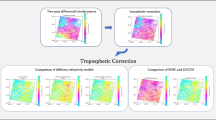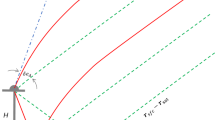Abstract
Numerical weather models offer the possibility to compute corrections for a variety of space geodetic applications, including remote sensing techniques like interferometric SAR. Due to the computational complexity, exact ray-tracing is avoided in many cases and mapping approaches are applied to transform vertically integrated delay corrections into slant direction. Such an approach works well as long as lateral atmospheric gradients are small enough to be neglected. But since such an approximation holds only for very rare cases it is investigated how horizontal gradients of different atmospheric constituents can evoke errors caused by the mapping strategy. Moreover, it is discussed how sudden changes of wet refractivity can easily lead to millimeter order biases when simplified methods are applied instead of ray-tracing. By an example, based on real InSAR data, the differences of the various troposphere correction schemes are evaluated and it is shown how the interpretation of the geophysical signals can be affected. In addition, it is studied to which extend troposphere noise can be reduced by applying the exact ray-tracing solution.
Similar content being viewed by others
References
Boudouris G (1963) On the index of refraction of air, the absorption and dispersion of centimeter waves by gases. J Res Natl Bur Stand 67: 631–684
Clark I (1979) Practical geostatistics. Applied Science Publishers Ltd, London
Foster J, Brooks B, Cherubini T, Shacat C, Businger S, Werner CL (2006) Mitigating atmospheric noise for InSAR using a high resolution weather model, Geophys. Res Lett 33: L16304. doi:10.1029/2006GL026781
Fujiwara S, Tobita M, Murakami M, Nakagawa H, Rosen PA (1999) Baseline determination and correction of atmospheric delay induced by topography of SAR interferometry for precise surface change detection (in Japanese with abstract and figures in English). J Geod Soc Jpn 45(4): 315–325
Furuya M, Mueller K, Wahr J (2007) Active salt tectonics in the Needles District, Canyonlands (Utah) as detected by interferometric synthetic aperture radar and point target analysis: 1992–2002. J Geophys Res 112: B06418. doi:10.1029/2006JB004302
Hanssen R (2001) Radar interferometry: data interpretation and error analysis. Kluwer, The Netherlands
Hobiger T, Ichikawa R, Koyama Y, Kondo T (2008) Fast and accurate ray-tracing algorithms for real-time space geodetic applications using numerical weather models. J Geophys Res 113: D20302. doi:10.1029/2008JD010503
Hobiger T, Ichikawa R, Koyama Y, Kondo T (2009) Computation of troposphere slant delays on a GPU. IEEE Trans Geosci Remote Sens 47(10): 3313–3318. doi:10.1109/TGRS.2009.2022168
Hobiger T, Shimada S, Shimizu S, Ichikawa R, Koyama Y, Kondo T (2010) Improving GPS positioning estimates during extreme weather situations by the help of fine-mesh numerical weather models. J Atmos Solar Terr Phys 72(2–3): 262–270. doi:10.1016/j.jastp.2009.11.018
Japan Meteorological Agency (2009) Monthly Volcanic Activity Report (in Japanese). http://www.seisvol.kishou.go.jp/tokyo/STOCK/monthly_v-act_doc/monthly_vact.htm
Paris DT, Hurd FK (1969) Basic electromagnetic theory. McGraw-Hill, New York
Shimada M, Ozawa T, Fukushima Y, Furuya M, Rosenqvist A (2008) Japanese L-band radar improves surface deformation monitoring. EOS Trans AGU 89: 277–278
Smith EK, Weintraub S (1953) The constants in the equation for atmospheric refractive index at radio frequencies. J Res Natl Bur Stand 50: 39–41
Tsuboki K, Sakakibara A (2002) Large-scale parallel computing of cloud resolving storm simulator. High Perform Comput 243–259. doi:10.1007/3-540-47847-7_21
Wadge G, Webley PW, Bingley R, Dodson AH, James IN, Waugh S, Veneboer T, Puglisi G, Mattia M, Baker D, Edwards SC, Edwards SE, Clarke P (2002) Atmospheric models, GPS, and InSAR measurements of the tropospheric water vapour field over Mount Etna. Geophys Res Lett 29(19): 1905. doi:10.1029/2002GL015159
Wessel P, Smith WH (1991) Free software helps map and display data. EOS Trans AGU 72: 441
World Meteorological Organization (2000) General meteorological standards and recommended practices. Appendix A, WMO Technical Regulations, WMO-No. 49, corrigendum, August 2000
Author information
Authors and Affiliations
Corresponding author
Rights and permissions
About this article
Cite this article
Hobiger, T., Kinoshita, Y., Shimizu, S. et al. On the importance of accurately ray-traced troposphere corrections for Interferometric SAR data. J Geod 84, 537–546 (2010). https://doi.org/10.1007/s00190-010-0393-3
Received:
Accepted:
Published:
Issue Date:
DOI: https://doi.org/10.1007/s00190-010-0393-3




